Биологические науки. Рубрика в журнале - Бюллетень науки и практики
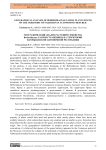
Статья научная
It becomes difficult to determine the first historical range of the plant, which moved far from its prehistoric territory. It has been controversial in this aspect to determine the historical geographical range of plants also included in the Berberis L. genus. Genera and species of Berberidaceae family in Nakhchivan AR migrated from the flora of the Caucasus, Central Asia, East Asia, Iran. The territory of Iran is dominant and represented by 4 species in this family. As a result of the analysis, it was found that plants belonging to the Berberidaceae family, found on the Territory of Nakhchivan Autonomous Republic which relate predominantly to xerophilic, Caucasian and boreal geographical types.
Бесплатно
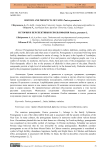
History and prospects of using Punica granatum L.
Краткое сообщение
Pomegranate has been used since antiquity in culture, traditions, cooking, crafts, arts and crafts, myths, fairy tales and other areas of creativity. Pomegranate is associated with long-term fertility, abundance and is considered a carrier of energy. In the past, in the legends of Azerbaijan, the pomegranate was considered a symbol of love and passion, and religious people saw it as a symbol of eternity. In medicine, the leaves, fruits, bark and roots of the pomegranate were used. Their therapeutic effect is due to the presence of alkaloids in these parts of the plant. Phenolic compounds provide a high level of antioxidant activity in the human body. Particular attention is paid to the pomegranate populations in the territory of Azerbaijan.
Бесплатно
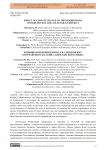
Impact of climate change on the dendroflora of Okhchuchay area of Zangilan district
Статья научная
Monitoring was carried out in Okhchuchay area of Zangilan district, and scientific research works were carried out in the surrounding areas of Agali village, Beshdeli village, Kechikli, Mammadbeyli, and Dagustu park. The aim was to study the impact of climate variability on biodiversity, to investigate the taxonomic composition of natural and cultivated dendroflora, bioecological characteristics. The natural dendroflora in Okhchuchay area of Zangilan district was studied, notes were made on the study of the modern state of plant species and analyzes were made in the direction of studying the role of biodiversity in ensuring the natural regeneration of rare species. Distribution areas of relict, endemic rare and endangered plants, economically important plants in Okhchuchay area of Zangilan district have been determined. Soil water samples were taken from the research area and its composition was investigated.
Бесплатно
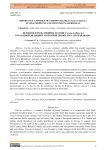
Статья научная
Corylus avellana L. is a very common valuable shrub that usually regenerates naturally in mixed forests. Hazelnut cultivation in Azerbaijan has a very ancient history. Since ancient times, people have cultivated wild types of hazelnuts and cultivated high-quality hazelnut plants. The composition of hazelnut fruit is protein, fat (about 60-70%), carbohydrates (15-17%), 45% water, phosphorus, calcium, magnesium, manganese, zinc, iron, etc. It is rich in minerals, vitamins A and E, B1, B5, B6, B9, B group vitamins. The root, stem, leaves and fruits of hazelnut are widely used in industry and medicine.
Бесплатно
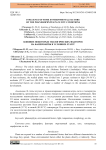
Influence of some environmental factors on the phanerophytes in ex situ conditions
Статья научная
The article studied and analyzed the effects of wind, light and temperature on the phanerophytes used in landscaping the Absheron Peninsula (Azerbaijan). When studying the interaction of light with the studied plants, it was found that 311 species are heliophytes, and 51 are sciophytes. The study showed that 298 species unstable to wind and 64 wind resistant. In terms of heat resistance, the studied plants were divided into 3 groups: resistant to high (54-56 °C), moderate (52 °C) and low (48-50°C) temperature. The results of the study showed that these environmental factors are crucial and make a number of changes in the dynamics of plant development.
Бесплатно
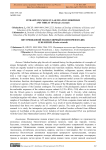
Intraspecies molecular DNA polymorphism and threat of Hirudo orientalis
Статья обзорная
Medical leeches play the role of a natural factory for the production of a complex of unique biologically active substances such as hirudin, eglins, bdellins, hementin, bradykinins, which are urgently needed by modern medicine and veterinary medicine. Medical leeches produce a wide range of enzymes such as hyalinodase, destabilase, collagenase, apyrase, elastase and triglyceride. All these substances are biologically active substances of natural origin. It is used to treat a wide range of diseases, such as amenorrhea, osteoarthritis, trauma, and blood stasis syndrome. In modern times, leeches also serve as an important model system for understanding the structure, function, development, regeneration, and repair of the nervous system. The currently seven known species of the Hirudo Linnaeus, 1758 genus of the Hirudinidae family are widespread in different regions of the Eurasian contingent. The results of the phylogenetic analysis based on the nucleotide sequences of the oxidase enzyme subunit I (12S r-RNA, COI) allow us to assume that the Hirudo genus is monophyletic. In 2005, P. Trontelj and S. Utevsky, while studying the molecular systematics of medical leeches, analyzed 2 samples of medical leeches from Azerbaijan together with others. According to the results of the cluster analysis, two medicinal leech samples of Azerbaijan ( Hirudo sp. AZ1 and Hirudo sp. AZ2) form a separate cluster and are located between H. medicinalis and H. verbana species. As a result of recent phylogenetic studies, it was determined that those two samples are H. orientalis species. The main goal of the conducted research is to study the intraspecies polymorphism of medical leeches collected from different regions of Azerbaijan at the genome level. Isolation of leech chromosomal DNA was performed with the Gene Elute Mammalian Genomic DNA miniprep reagent kit.
Бесплатно
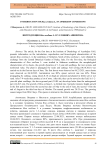
Introduction of Bixa orellana L. in Apsheron conditions
Статья научная
The article, for the first time at the Institute of Dendrology of Azerbaijan NAS, presents information on the introduction, reproduction and bioecological characteristics of the species Bixa orellana L. in the conditions of Absheron. Seeds of Bixa orellana L. were obtained by exchange from the Central Botanical Garden of Padua, Italy. For the first time, the biological characteristics of Bixa orellana L. were studied in Absheron conditions, the morphological characteristics of its shoots, the growth dynamics of 1-2-year-old seedlings, the root system, and nutritional value. The plant is propagated by seeds and cuttings. Soil sowing (06.10.2021) was carried out in the first ten days of June. The first shoots were observed on 06.23.2021, mass shoots were observed on 06.30.2021. Germination was 80%, sprout survival rate was 60%. When propagating by cuttings, young shoots 8-10 cm high are selected and planted in fertile soil or wet sand. After 7-9 weeks they produce a lot of roots. After this, they can be moved to the field. In 1-2-year-old plant seedlings, the above-ground part (39-80 cm) develops better than the underground part (14-26.5 cm). The growth of Bixa orellana L. is divided into 2 periods; intensive height growth in the first period lasts from the second ten days of May to the end of June, the second - from the end of August to the third ten days of October. The annual growth was 20-25 cm. The growing season ranges from 280±5 days. This species is tolerant to the climatic conditions of Absheron.
Бесплатно
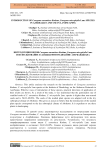
Статья научная
This article analyzes the research on the introduction of Caragana aurantiaca Koehne, C. microphylla Lam species at the Institute of Dendrology on the Absheron Peninsula in Azerbaijan. Effective ways of introduction of these species, practical directions of application of their results are shown. As a result of the study, it was determined that the germination rate of scarified seeds of C. aurantiaca Koehne, C. microphylla Lam. species is higher than non-scarred seeds and is 56.02-69.09%. The seeds of the studied plant species are adapted well in the dry subtropical climate of Absheron. This gives us reason to believe that the introduction of the studied plant species corresponds to the dry subtropical climate of Absheron. It is expedient to use these plants in landscaping.
Бесплатно
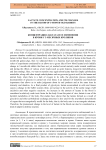
Lactate concentration and its changes in the blood of 3-month-old rabbits
Статья научная
It was performed on 3-month-old rabbits, which were exposed to acute (20 minutes) and severe form of exogenous hypoxia (forced breathing in a nitrogen atmosphere with 5% O2 in pressure chamber conditions). Immediately after that (in the 1st, 3rd and 6th hours), the amount of lactate in their blood was determined. First, we studied the normal level of lactate in the blood of 3-month-old guinea pigs, then we subjected them to a hypoxia load and determined lactate. This series of experiments conducted by us allows us to get an idea of how blood lactate levels initially change in 3-month-old rabbits that have not yet reached sexual maturity under normal conditions and during the effects of various severe loads (such as acute hypoxia, long-term immobilization, and fast running). Here, we want to mention once again about lactate that this simple carbohydrate metabolite, along with other simple carbohydrates such as pyruvate (pyruvic acid) in the human and animal body, when there is a lack of oxygen in its cells, the glycolysis process (anaerobic decomposition of glucose) is carried out even faster, is an indicator of metabolic and functional importance that allows us to make judgments about its end products and at the same time its intensity and duration. As a final product of glycolysis, lactate accumulated in cells and tissues causes a change in the buffer systems there, an increase in the activity of the acidic range of pH (acidosis) and other negative reactions. An increase in the amount of lactate in the blood is considered a relatively weak toxic factor for the body. From this point of view, lactate is one of the harmful metabolites of the body. But studies have shown that the lactate formed as a result of glycolysis and other carbohydrate exchange processes is also used for the resynthesis (resynthesis) of sugars that are energetically useful for the body, that is, the body uses it as an energetic substrate. Therefore, the pronounced change in the level of lactate in the blood can also be considered as a kind of adaptive-defense reaction.
Бесплатно
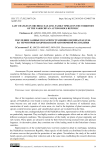
Статья научная
Species content and distribution patterns of the Orchidaceae Juss. Family in the Nakhchivan Autonomous Republic have been studied. Considering last changes in literature data, materials included in the herbarium fund and the performed researches, 21 species of the Orchidaceae Juss. Family belonging to 8 Genera have been established in the territory of the Autonomous Republic.
Бесплатно
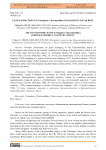
Leaf-eating insects damaged to sugar beet (Coleoptera Chrysomelidae)
Статья научная
Provides information on pests belonging to the Chrysomelidae family of the Coleoptera order based on the research conducted in the farms of Imishli district, which is one of the main sugar beet growing regions of Azerbaijan. During the research years, 3 species (Chaetocnema concinna (Marsham, 1802), Ch. breviuscula (Faldermann, 1837), Cassida nebulosa Linnaeus, 1758) belonging to 2 genera (Chaetocnema Stephens, 1831, Cassida Linnaeus, 1758) of the Chrysomelidae family of the Coleoptera order were found in the stationary fields was observed. Information about some bioecological and phenological characteristics of the mentioned species is reflected in the article.
Бесплатно
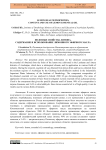
Lemon health properties, content and use of lemon essential oil
Статья научная
The presented article provides information on the chemical composition of the essential oil obtained from the fruits of the lemon tree cultivated in the Lankaran and Astara districts of Azerbaijan, which have a subtropical climate, and its application in various fields of industry. During the research, essential oil was obtained from lemon fruits and leaves collected from the southern regions of Azerbaijan by the Ginzberg hydrodistillation method in the Industrially Important Plants laboratory of the Institute of Dendrology. The component composition of the obtained essential oil was analyzed in Kristal 2000 M gas chromatography. The areas of application of lemon essential oil have been investigated: Lemon essential oil has a pleasant aroma. Citral is the component that gives the specific pleasant smell of lemon. 90% of its composition is terpene-limonene, and 3-6% is citral aldehyde. Since lemon essential oil is of high quality, it can be widely used in various fields of industry.
Бесплатно
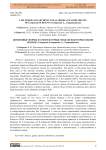
Статья научная
Campanula L. is the largest genus of Campanulaceae family and comprises about 400 (as well as 110 species in Caucasus and 46 species in Azerbaijan flora) herbaceous perennial, sometimes annual and biennial monocarp species distributed in the temperate zone of the northern hemisphere. Most of Campanula species are cosmopolitan. The species of this genus have long been used in the national economy, primarily as decorative plants, but also as pollinator, melliferous, food and medicinal plants. The genus Campanula L. yet does not have a modern taxonomic classification, although many species are of high horticultural value, and many are rare and endangered. The only monograph was published by A. de Candolle (1830). The final systematic composition of the genus was given in Flora of the Caucasus by M. E. Oganesian and V. V. Shvanova (2008). Representatives of this genus grows in various environmental conditions: forests, meadows, rocks and rarely in deserts and semi - deserts. Most of them are numerous and varied in high mountains, in the subalpine and alpine belts.
Бесплатно
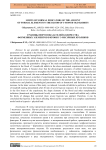
Limits of normal indicators of the amount of formal elements in the blood of 3-month-old rabbits
Статья научная
In our scientific research, several physiologically and biochemically important parameters were studied in the blood of 3-month-old rabbits: glucose hemostasis, pH-indicator and the amount of immune hemoglobin. In this experiment, we obtained interesting facts about hypoxia and physical loads, the initial changes in blood and their dynamics during the joint application of these factors. We considered that in the experimental work carried out in this direction, it is also important to study the quantitative changes of the main morphological (cellular) structures-shaped elements in the blood of 3-month-old rabbits in the above-mentioned experimental models. From the obtained results, it became clear that the physiological necessity of neither leukocytes, nor lymphocytes, nor monocytes to strengthen the body’s immune defense system during such physical loads is almost too weak, this was confirmed in a number of experiments. This is also shown by our research work. However, a number of experimental evidence show that very high motor activity can lead to a more or less increase in the number of platelets in the animal body. Due to the increase of erythrocytes and platelets, hematological parameters such as hematocrit and thrombocrit can also increase. In the latter version of this study, we induced 3-month-old rabbits to perform a 10-min act of treadmill running immediately after 20 min of severe hypoxic exposure. It is very interesting that in the first hours of the experiment, the shape elements of the blood and other morphometric indicators (hemotocrit and thrombocrit levels) were manifested in 3-month-old rabbits only within the limits of changes that occurred when severe hypoxia was applied. Therefore, it can be concluded that hypoxia is the factor affecting blood and its composition in a complex experimental model such as hypoxia + physical load.
Бесплатно
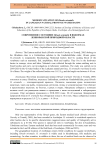
Modern situation of Hirudo orientalis in Lankaran natural province water basins
Статья научная
The Eastern medical leech ( Hirudo orientalis Utevsky et Trontelj, 2005) belongs to the Hirudinea class to a Euhirudinea subclass to the Gnathobdellidae order, Hirudo genus. H. orientalis is ectoparasitic bloodsucking. Medicinal leeches feed by sucking blood of the vertebrates such as mammals, fish, amphibians, birds and reptiles. They live in the freshwater basins in swamps, rivers and lakes. Materials were collected through the suture-catching nets to breed leeches and carry out investigations in laboratory conditions. The study was carried out in 2018-2020 in the 42 water bodies of the Lankaran natural province. H. orientalis was found in only 16 of them. The weight of the collected leeches was 1.0-2.5 g, and the length was between 4-10 cm.
Бесплатно
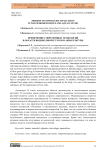
Modern technologies application in water bioresources and aquaculture
Статья обзорная
The production and use areas of aquatic plants are investigated in the article. In recent times, the development of fishing and the all-round use of aquatic plants (as food, the purchase of environmentally oil, as fertilizer) is one of the main issues of our day. Macroalgae are the basis of the cultivated sea products. Mainly, brown algae - laminaria, fucus, red algae - Kappaphycus alvarezii and Eucheuma are widely used for both food and alginate production. Spirulina algae, a representative of blue-green algae living in freshwater basins is one of the most cultivated and widely used algae. The fact that its composition is rich in proteins and vitamins creates the basis for the widespread use of algae. Algae thallome contains 60% protein, amino acids, oils, mineral salts, and fatty acids, which help to strengthen the immune system and eliminate anemia. In addition, biological substances obtained from algae active substances are easily absorbed by the body, it is one of the important substances for the regeneration of liver cells.
Бесплатно
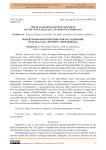
Molecular-Phylogenetic Research of the Genus Hypericum L. in Flora of Azerbaijan
Статья научная
Hypericum is one of the 100 largest flowering plant genera forming the family Hypericaceae Juss., which belongs to the clusioid clade of the Malpighiales. Hypericum is represented in Azerbaijan flora by 19 native species and 1 subspecies belonging to 7 taxonomic sections. The chloroplast DNA of 8 species from the genus was studied by PCR-RFLP analysis. Total genomic DNA was extracted from leaf tissue using the DNeasyPlantMini kit. (Qiagen Inc.; Valencia, CA, USA) following the supplied protocol and quanti field using a Nanodrop (Nanodrop Technologies; Wilmington, DE, USA) spectrophotometer. The article is part of an experimental study that comprises molecular-phylogenetic research of this genus in the flora of Azerbaijan.
Бесплатно
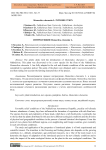
Momordica charantia L. introduction
Статья научная
The article deals with the introduction of Momordica charantia L. plant in Nakhchivan. This plant was discovered to be a new species for the flora of the Nakhchivan. Momordica charantia L. has fully adapted to the soil and climatic conditions of the area and has completed its vegetation period. The seeds of the plant were obtained, and it was recommended to use them taking into account the farming characteristics of the species.
Бесплатно
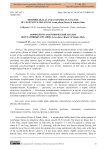
Morphological and anatomical analysis of vegetative organs of Avena pilosa (Roem. & Schult.) Bieb
Статья научная
The article provides information about the structural features of the fodder plant - Avena pilosa (Roem. & Schult.) Bieb., which is widespread on winter pastures in Azerbaijan. As a result of the morphological-anatomical analysis, important structural elements were identified, as well as the morphophysiology and adaptation of this species. As a result of adaptation to drought conditions, this plant showed signs of strong xerophilization. Xerophytes - plants for which the aridity of the norm. Common symptoms of xerophytes - a small evaporating surface, and other structural and physiological symptoms are very diverse. Reduction of leaf area is the main morphological feature of xerophytes.
Бесплатно
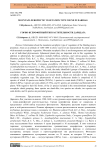
Mountain-xerophytic vegetation type found in Daridag
Статья научная
Information about the mountain-xerophytic type of vegetation of the Daridag area is presented. Areas at an altitude of 1200-1600 m above sea level are characterized by plant species with mountain xerophytic vegetation. Mountain xerophytic flora is not homogeneous and represents a set of individual phytocenosis. Ephemeral plants play an important role in this vegetation. In addition to ephemerals, the vegetation includes bulbous, tuberous, and various grasses, mainly: Rhamnus pallasii Fisch. & C. A. Mey. , Astragalus microcephalus Willd. , Astragalus beckerianus Trautv., Astragalus aduncus Willd., Thymus kotschyanus Boiss. & Hohen., T. collinus M. Bieb., Euphorbia seguieriana Neck., Caragana grandiflora (M. Bieb.) DC., Atraphaxis spinosa L., Acanthophyllum mucronatum C. A. Mey., Zygophyllum atriplicoides Fisch. & C. A. Mey., Z. fabago L., Acantholimon araxanum Bunge etc. In total, the study identified 6 groups of formations and 16 associations. These include thorn shrubs, monodominant tragacanth xerophytic shrubs, cushion xerophytic shrubs, subshrub phrygana and mixed shrubs, which are included in the mountain xerophytic vegetation type. The phytocenosis of mixed herbaceous shrubs is comprised of 35 species, of which 10 species are shrubs (28.56%), 1 species is a semi-shrub (2.86%), 1 species is a shrub (2.86%), 2 species are semi-shrubs (5.72%), and 21 species are perennial and biennial (60%) plants. With regard to their life forms, of the 21 species included in the monodominant tragacanth xerophytic shrub grouping, three species are shrub-like, two species are shrubs, two species are semi-shrubs, and 14 species are perennial grasses.
Бесплатно

